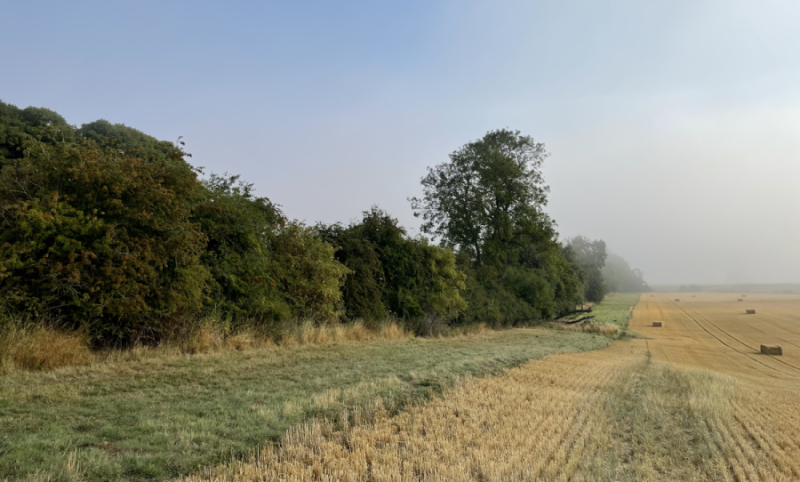Going Green: Understanding Ecological Focus Areas
9 September 2025The conditions tied to the Basic Payment Scheme (BPS) are evolving. In the past, greening obligations mainly applied to arable farms, with growers required to set aside management options equivalent to 5% of their arable land. Dairy farmers who historically had more than 75% of their claim in grass or other herbaceous forage were generally exempt. With the new requirement, coming in 2026, that every business with at least 15 hectares of arable land must now participate in greening, far more dairy producers will be formally drawn into the system.
Greening – often referred to as managing Ecological Focus Areas (EFA) – is not a new concept. Those who remember the days of set-aside will recognise the principle: dedicating parts of the farm to environmental management. The aim is to put in place measures that protect soil health, improve habitats for wildlife, and contribute to reducing on-farm emissions.
All farmers that trigger the new arable threshold for greening will be required to select from an expanded list of EFA interventions, up from 7 to 11, to satisfy their calculated obligations. In recognition that different options will have different beneficial impacts or increased management needs, options are weighted – this has been summarised in the following table.
Greening must be completed only after careful thought and consideration, as breaches and non-compliance will result in financial penalties and reduced levels of farm support. A comprehensive guide to all the options available, the process and record keeping requirements can be found in the Ecological Focus Areas section on the Rural Payments & Services webpage.
FAS has also produced a video walking you through all the changes:
EFA Options
Below is a comprehensive table outlining each of the 11 EFA options under Scotland’s Greening Guidance 2026, along with their corresponding weighting factors — that is, how much each hectare (or metre, for hedges) counts towards meeting the 5% EFA requirement:
| EFA Option | EFA Code | Weighting | How to Calculate EFA Contribution | |
|---|---|---|---|---|
| Fallow land (arable) | EFAFAL | 1 | 1 ha = 1 ha towards EFA requirement | |
| Field margins / buffer strips | EFAM | 1.5 | 1 ha = 1.5 ha equivalent | |
| Catch crops (under-sown) | EFACC | 0.3 | 1 ha = 0.3 ha equivalent | |
| Green cover (autumn-sown cover crops) | EFAGC | 0.3 | 1 ha = 0.3 ha equivalent | |
| Nitrogen-fixing crops | EFA-NFIX | 1 | 1 ha = 1 ha equivalent | |
| Agro-forestry / small & farm woodland | EFAAF | 1 | 1 ha = 1 ha equivalent | |
| Hedges (claimed whole hedge) | EFAH100 | Linear metres × 10 m² | 1 metre = 10 m² (0.001 ha) equivalent | |
| Hedges (claimed shared boundary only) | EFAH50 | Linear metres × 5 m² | 1 metre = 5 m² equivalent | |
| Low-input grassland | EFALIG | 0.2 | 1 ha = 0.2 ha equivalent | |
| Herb & legume-rich pastures | EFAHLRP | 1.5 | 1 ha = 1.5 ha equivalent | |
| Unharvested crop (left for wildlife) | EFAUHC | 1.5 | 1 ha = 1.5 ha equivalent |
Examples Of The New Greening Requirements
In practical terms, the following shows two scenarios where two different dairy businesses have triggered their greening requirements and must undertake EFA.
Scenario 1: 180-cow dairy herd with 60 hectares of silage and cereals
Farm profile:
- Total farm: 120 ha
- Arable land: 20 ha wholecrop cereals, 10 ha maize, 30 ha temporary grass (all count as arable)
- Permanent pasture: 60 ha
Greening trigger:
With 60 ha of arable, this business is above the 15-ha threshold and must map out EFAs equivalent to 5% of its arable area → 3 ha EFA required.
Meeting the requirement:
- Field margins: The farm already has 2 km of grass margins along watercourses. At 10 m² per metre, that equates to 2 ha EFA credit.
- Nitrogen-fixing crops: A 2 ha block of red clover silage can be counted as nitrogen-fixing. At a weighting of 1.0, that adds 2 ha credit.
Total EFA credit: 4 ha (requirement = 3 ha) → Compliant.
Take-home point: By mapping existing margins and recognising the clover crop, the farm satisfies greening without any land being taken out of production.
Scenario 2: 120-cow dairy herd with 20 hectares arable
Farm profile:
- Total farm: 120 ha
- Arable land: 10 ha spring barley, 10 ha spring wheat
- Grassland: 100 ha permanent pasture
Greening trigger:
20 ha arable land → farm must allocate 5% as EFA = 1 ha equivalent.
Meeting the requirement:
- Field margins: Along two watercourses, the farmer maintains 700 m of grass buffer strips averaging 4 m wide. At 10 m² per metre, this provides7 ha EFA credit.
- Green cover: After harvesting 5 ha of maize, the farmer establishes an autumn cover crop (ryegrass/vetch mix). With a weighting of 0.3, this delivers5 ha EFA credit.
Total EFA credit: 2.2 ha (requirement = 1 ha) → Compliant.
Take-home point: By combining existing buffer strips with a cover crop on maize land (already useful for soil protection and nutrient capture), the farm more than meets its greening obligation — no need for extra land to be taken out of production.
In summary, greening requirements will affect far more farmers in 2026, but the dairy sector is well positioned to undertake the necessary actions to safeguard their support payments. Indeed, for many, the greening process will be about formalising and acknowledging existing good practice, rather than substantial system change.
Time and preparation are key to a good transition into a new system. Please seek advice and think through your options, ideally well in advance of the next SAF window. Support is available through the FAS advice line by calling either 0300 3230161 or emailing advice@fas.scot.
Sign up to the FAS newsletter
Receive updates on news, events and publications from Scotland’s Farm Advisory Service

